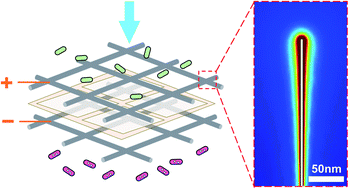Development of nanowire-modified electrodes applied in the locally enhanced electric field treatment (LEEFT) for water disinfection
Abstract
Locally enhanced electric field treatment (LEEFT) is introduced as a nanowire-enabled physical water disinfection method with the advantages of low energy consumption, wide spectrum effectivity, and the absence of disinfection by-product (DBP)-forming chemical additives. The electrodes used for LEEFT are modified with nanowires, which enhance the electric field near the nanowire tips significantly. Even with a very low external applied voltage (usually <10 V), the local electric field strength is high enough to enable irreversible electroporation, thus causing microbial inactivation. Here, the development of nanowire-modified LEEFT electrodes is reviewed in terms of their reasoning of material selection, synthesis, characterization, and disinfection performance. Subsequently, we summarize the desired properties of the LEEFT electrodes (e.g., high conductivity, appropriate nanowire morphology, high durability, and low to no toxicity to humans and the environment), point out the strategies of developing new electrodes for the LEEFT, and propose a guideline on how to evaluate electrodes developed in the future. In the end, the challenges and opportunities of LEEFT electrodes for practical application are also discussed.

- This article is part of the themed collection: Journal of Materials Chemistry A Recent Review Articles


 Please wait while we load your content...
Please wait while we load your content...
